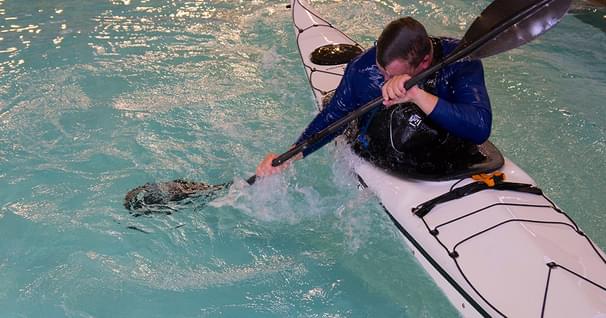Proper Technique for Paddling a Kayak
One of the greatest things about kayaking is that pretty much anybody can hop in and do it. But you need to understand that by developing good technique, you'll not only paddle more efficiently, but you'll be safer on the water.
In particular, poor technique will tire your body much more quickly, and leave you less prepared to deal with a change in conditions or dangerous situations. Practicing good technique will also equip you to deal with unexpected and challenging water or weather conditions. So in this video, we're going to look at a few simple ways to improve your paddling technique and make you more comfortable and safer on the water.
The first things we're going to look at is the proper sitting position in a kayak. One of the things that separates a very basic kayak from a higher quality kayak is the comfort of the seat. In fact, many kayaks have seats that are so comfortable, they make you want to lounge in them. Of course, there's nothing wrong with lounging in a kayak. But for the purposes of paddling, you need to sit up and have good posture. Sitting up straight with good posture will let you paddle harder, faster, and it'll help you avoid issues like back pain.
Paddling with good posture means sitting upright and not leaning back. Your feet should be resting comfortably and securely against the foot pedals, and your legs should be comfortably flexed and a little splayed out. This leg position makes sitting upright easier and reduces the strain on your hamstrings and back. Quality kayaks also come with some type of adjustable back support, which can be loosened when you want to kick back and relax, and tightened when to encourage an upright sitting position.
50 years of lightweight, maneuverable, high-performing kayaks.
Check out this interview with Tom Keane, Eddyline Kayaks Co-Owner, on their journey!
The second technique we're going to look at is how to properly use your paddle. The first thing to know about kayak paddles is that some are feathered and some are unfeathered. Unfeathered paddles have blades that are lined up with one another. Feathered paddles have blades that are opposite from each other to some degree. The offset of feathered paddles is designed to let the upper blades slice through the air and wind more easily when you take a forward stroke. The trade-off is that you need to twist the paddle when moving from one stroke to the next.
So let's take a closer look at the correct way to use a feathered paddle. In most cases, feathered paddles are designed for right-handed people, which means your right hand is your control hand. Your right hand maintains a firm but relaxed grip on the paddle at all times. Your control hand should grip your paddle and your big knuckles should be aligned with the edge of your paddle blade. Your other hand should be holding the paddle an even distance from other blade.
An easy way to check to see if your hands are in good position is to lift your paddle onto your head. Your elbows should be bent at around 90 degrees, because this will give you the best mix of control and power. Now, after taking a stroke with the blade by my control hand, you'll loosen your other hand, which is often called the "grease" hand, so that you can rotate the shaft within it. This rotation is necessary to accommodate the feather or twist of your paddle so that your next blade can be placed squarely in the water. This loosening of the grease hand and the rotation of the shaft within it takes place between each stroke. If you're using an unfeathered paddle, you won't need to worry about rotating the shaft between strokes, which is why most people find this more natural.
One last thing to mention is that even though we refer to the control hand sometimes as the "glue" hand, it's important that that control hand maintains a secure but light grip. A light grip will let you paddle more comfortably for longer, and it'll help you avoid overuse injuries like tendinitis.
• How to Hold a Kayak Paddle • The Kayaking Forward Stroke • The Kayak Stroke: Finesse over Power
• How to Sit in a Kayak: Cockpit Overview • The Kayak Forward Stroke
Related Articles
By changing how you edge and balance your boat you can increase your stability and adaptability. Using…
Mention “pool session” and the first image that pops into most kayakers minds is a class in how to roll.…
Photo Credit: Darlene Patterson Many people who have paddled for years can't keep a canoe on a straight…
Most people are concerned with how to get their standup paddle board moving forward, but it's just as…




